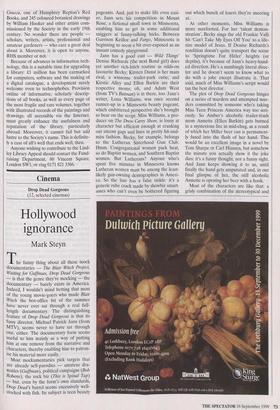Gardens
Treasure store
Ursula Buchan
King of the Pippins' by William Hooker Whatever happened about the Lindley Library? This question has surely been at the very forefront of readers' minds in the past few years. For those too young to remember, let me explain.
In November 1994, the Council of the Royal Horticultural Society decided to move the Lindley Library (the largest and finest horticultural library in the world) from its cramped and unsuitable eyrie on the top floor of its headquarters at 80 Vin- cent Square, Westminster, to the Society's gardens at Wisley, Surrey. Many members (including your correspondent) were cross that they had not been properly consulted and that the decision was taken after the last date when a resolution could be submitted for the AGM the following February. The ensuing row spilled over from the gardening to the news pages of the national press.
Faced with the threat of an Extraordi- nary General Meeting, requisitioned by many of those who attended the AGM, the Council agreed to set up an enquiry under Sir Ralph Gibson, a retired Lord Justice of Appeal, and to allow the members to vote on the options he identified. The members voted substantially for a 'split library', that is, for branches in both London and at Wis- ley, with the Library Committee choosing what went where. The RHS designated the London site for development as phase one, with phase two consisting of a new modern science and education centre, incorporat- ing a library, at Wisley.
By great good fortune, the Council had been introduced to Rick Mather, the archi- tect responsible for remodelling the Natio- nal Maritime Museum, and currently the Wallace Collection and Dulwich Picture Gallery, when he produced a feasibility study for the redundant Rochester Row Police Station in 1995, considered by some members as a possible site for the Library. His practice won the design competition to remodel 80 Vincent Square (dating from 1904, designed by E.J. Stebbs and listed), to provide suitable accommodation both for the Library and for the Society's admin- istration. His imaginative plan consisted of redesigning the storage basement, and a small part of the Old Horticultural Hall above it, for the new library, an option which, before the members' uprising, had been dismissed as impossible. (The offices will be housed in the upper storeys, includ- ing a new mezzanine floor in the air space above the Old Hall.) The new library will contain enough stor- age for more than 25 years' expansion and provide enhanced staff and reader facili- ties, including more than double the read- ing room capacity, exhibition space, a dark room, a conservation room, computer work stations and disabled access. Lighting, tem- perature and humidity will be controlled and there will be better fire precautions. Basements, being cool, are ideal places for libraries, but this one also has roof lights on the street side, so it will be a light and pleasant place to work. The fagade will remain unaltered, of course.
The remodelling of the library will cost £4 million. So far, the Heritage Lottery Fund has promised a £1.8 million grant, charitable trusts and large donors have come up with nearly £1 million and the members, bless 'em, have provided £335,000 — an average of £1.25 each. Just under £1 million is still needed by the end of the year, but the Society seems confident of achieving the target.
Work started on phase one at the begin- ning of this month, and the library is expected to open in January 2001. Mean- while, Dr Brent Elliott and his small staff, together with the contents of the library, are crammed for the duration, like cheery refugees from the Blitz, into the basement of the New Horticultural Hall across the road in Greycoat Street. Access to books by readers is still possible, although neces- sarily limited.
In the old days, the Lindley Library was housed in such a confined and insecure space, that the Society was careful not to advertise its merits widely. Even long-tune members had no idea what a treasure store it was: 50,000 books, 1,500 periodicals, 18,000 drawings, together with trade cata- logues, photographs and archives. Priceless gems include Pliny the Elder's Historia nat- uralis, printed in 1514, Sibthorp's flora Graeca, one of Humphrey Repton's Red Books, and 245 coloured botanical drawings by William Hooker and other artists com- missioned by the Society in the early 19th century. No wonder there are people scholars, writers, artists, professional and amateur gardeners — who care a great deal about it. Moreover, it is open to anyone, RHS member or not.
Because of advances in information tech- nology, this is a suitable time for upgrading a library: £1 million has been earmarked for computers, software and the making of a digital catalogue, a development surely welcome even to technophobes. Provision online of informative, scholarly descrip- tions of all hooks, as well as every page of the most fragile and rare volumes, together with illustrated records of the paintings and drawings, all accessible via the Internet, must greatly enhance the usefulness and reputation of the library, particularly abroad. Moreover, it cannot fail but add lustre to the Society's name. This is definite- ly a case of all's well that ends well, then.
Anyone wishing to contribute to the Lind- ley Library Appeal should contact the Fund- raising Department, 80 Vincent Square, London SW1, or ring 0171 821 3366.



























































































 Previous page
Previous page